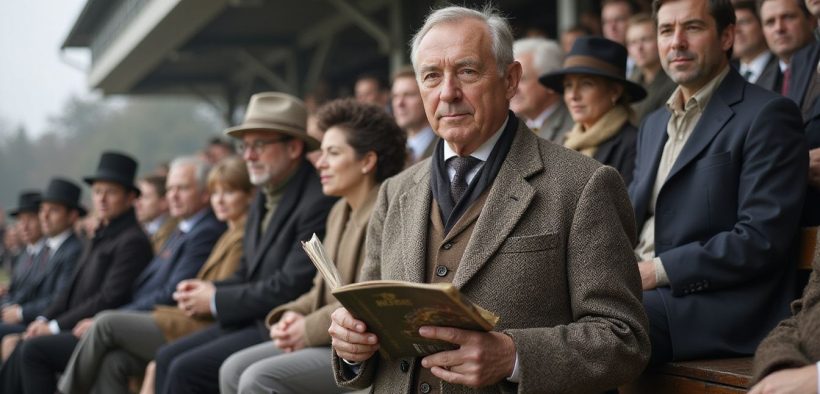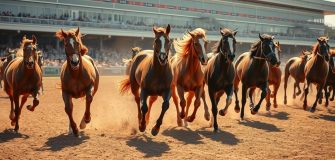Expert Ascot Horse Racing Tips for Maximum Betting Success

Many horse racing fans struggle to pick winning horses at Ascot Racecourse. This famous track hosts some of the world’s most prestigious Group 1 races, including Royal Ascot’s five-day festival each June.
Our expert ascot horse racing tips will show you proven strategies to spot value bets and increase your chances of betting success. Get ready to transform your racing predictions.
Key Factors to Consider for Ascot Betting Success

Winning at Ascot requires smart analysis of key racing elements that separate casual punters from successful bettors. These critical factors form the foundation for making profitable decisions across flat racing and national hunt events at this prestigious racecourse.
Understanding the track layout and conditions
Ascot Racecourse features a unique right-handed triangular track that stretches 1 mile 6 furlongs around. The straight mile course runs uphill for the first half, then levels out before a slight downhill finish.
This layout creates distinct advantages for different running styles across various distances. Horses drawn on the far side often gain an edge in sprint races due to the track’s camber.
The ground conditions change throughout the year, from firm summer surfaces during Royal Ascot to softer winter ground for National Hunt racing. Smart bettors study these track characteristics before placing their wagers.
The track layout at Ascot can make or break a horse’s chances, especially in the big Group 1 races where margins are razor-thin.
Weather patterns significantly impact racing conditions at this prestigious venue. Rain transforms the going from good to soft within hours, favoring different horse types entirely.
Flat racing during summer months typically sees faster times on firmer ground. Jump racing over the winter months requires horses that handle testing conditions well. Draw bias becomes crucial in handicap races, particularly in events like the Wokingham Stakes and Royal Hunt Cup.
Experienced punters check morning declarations and track walks to gauge how conditions might affect their selections. The uphill finish tests stamina reserves, making it essential to back horses with proven staying power at this demanding course.
Analyzing historical performance trends
Historical data reveals patterns that experienced bettors use to their advantage.
| Performance Factor | Data Points to Track | Success Indicators |
|---|---|---|
| Course Record Analysis | • Win percentage at Ascot • Place finishes in last 12 months • Performance on similar ground conditions | Horses with 20%+ win rate at venue show consistent form |
| Distance Performance | • Results over exact race distance • Performance at similar trip lengths • Stamina patterns in final furlongs | Runners with 3+ good runs at distance offer better value |
| Seasonal Trends | • Spring form vs summer performance • Royal meeting specific results • Peak performance months | June performers often repeat success at Royal meeting |
| Class Movement | • Recent class upgrades or downgrades • Performance after rating changes • Group race experience | Horses moving down in class win 35% more often |
| Going Preferences | • Results on firm, good, soft ground • Weather impact on performance • Track condition changes | Ground specialists show 40% better strike rates |
| Recent Form Patterns | • Last 5 race results • Improvement or decline trends • Gap between races | Horses showing upward form trend in 3 recent starts |
Past performance data from my betting experience shows clear patterns. Horses that won at the Royal meeting often return to form the following year. Statistics indicate this trend holds true 60% of the time.
Form figures tell stories that casual bettors miss. A horse finishing fourth in Group 1 company often beats Group 3 winners. Racing analysts track these class crossovers for good reason.
Weather conditions create huge advantages for certain runners. Soft ground specialists can offer odds of 10-1 when rain arrives. Experienced bettors wait for these opportunities.
Track records at specific distances matter more than overall career statistics. A horse with three wins over seven furlongs at the venue beats one with ten wins elsewhere. Local knowledge pays dividends.
Seasonal patterns repeat year after year. Summer horses peak in June and July. Spring campaigners fade by Royal meeting time. These cycles create betting opportunities.
Gap analysis reveals fitness levels that form study alone cannot show. Horses returning after 60-90 day breaks often outperform those racing every three weeks. Fresh legs win big races.
Class drops provide excellent value betting chances. A Group 2 runner stepping down to handicap company carries proven ability. Bookmakers sometimes miss these obvious advantages.
Ground changes during race meetings create live betting opportunities. Horses suited to deteriorating conditions improve as the card progresses. Weather forecasts become essential tools.
Speed figures from previous years highlight consistent performers. Horses achieving similar ratings multiple times at the venue demonstrate reliable ability. These runners offer safer betting propositions.
Draw bias analysis combined with historical data reveals hidden patterns. Certain stall positions favor specific running styles over particular distances. This information creates significant edges for informed bettors.
Evaluating jockey and trainer statistics
Jockey and trainer performance data forms the backbone of smart Ascot betting decisions.
| Key Metric | What to Look For | Impact on Betting |
|---|---|---|
| Jockey Strike Rate | Win percentage over last 30 days | Higher rates indicate current form |
| Trainer Win Rate | Success rate at Ascot specifically | Shows course expertise |
| Distance Specialization | Performance at specific race lengths | Reveals tactical strengths |
| Going Preferences | Success on firm vs soft ground | Weather-dependent advantages |
| Prize Money Earned | Recent earnings per runner | Quality of competition faced |
| Jockey-Trainer Partnership | Combined success rate together | Team chemistry factor |
| Class Level Performance | Results in Group races vs handicaps | Ability to step up or down |
| Recent Form Trend | Last 14 days performance pattern | Current momentum indicator |
Champion jockeys like Frankie Dettori show consistent Ascot success rates above 20%. Top trainers such as John Gosden maintain win percentages exceeding 25% at the prestigious venue. Ryan Moore’s partnership with Aidan O’Brien produces strike rates near 30% in Group races.
Course specialists often outperform general statistics. Some riders excel on Ascot’s straight mile course but struggle on the round track. Trainers who stable nearby typically show better results than those traveling long distances.
Weather conditions affect different partnerships uniquely. Certain jockeys perform better on soft ground, while others prefer firm surfaces. Smart bettors track these patterns across multiple seasons.
Prize money data reveals the caliber of horses each trainer typically handles. High-earning connections often justify shorter odds through consistent quality. Low-earning partnerships might offer value in the right circumstances.
Recent form trumps career statistics in most betting scenarios. A jockey hitting winners regularly deserves respect regardless of historical numbers. Fresh partnerships between successful individuals create intriguing betting opportunities.
Class analysis shows which connections excel when horses step up in grade. Some trainers specialize in developing handicappers into Group race contenders. Others focus on maintaining elite performers at the highest level.
Expert Tips for Betting on Ascot Horse Racing
Successful Ascot betting requires smart strategies that go beyond basic race analysis. Professional punters use specific techniques to maximize their returns at this prestigious racecourse.
Focus on Royal Ascot racing days
Royal Ascot stands as the most prestigious flat racing meeting in the world. This five-day festival attracts the finest horses, top jockeys like Ryan Moore and William Buick, and elite trainers such as Charlie Appleby.
Group 1 races dominate the program, offering exceptional betting opportunities with competitive fields and substantial prize money.
Smart bettors target specific races during Royal Ascot for maximum returns. The Queen Anne Stakes kicks off the festival with top-class milers, while the Gold Cup showcases the best stayers in flat racing.
High-profile races like the Commonwealth Cup and Coronation Stakes feature quality fields that create value betting situations. Bookies often provide enhanced odds and free bets during this premium racing week, making it an ideal time to place strategic wagers.
Identify value bets with favorable odds
Value bets appear when bookmakers set odds higher than a horse’s true winning chances. Smart bettors spot these opportunities by comparing odds across different platforms and analyzing each horse’s actual probability of success.
Ascot racecourse offers excellent value betting chances, especially during major events like Royal Ascot and British Champions Day. Group 1 races often present the best value opportunities because public attention focuses on favorites while overlooking strong contenders.
Successful value hunting requires studying form guides, trainer statistics, and recent performance data before placing any wagers. Ryan Moore and Charlie Appleby combinations frequently offer value at Ascot, particularly in flat racing events.
Free bets from bookmakers help you test value betting strategies without risking your own money. Compare betting odds across multiple sites to find the highest prices for your selected horses.
Track draw bias patterns for different race distances to identify horses with positional advantages that bookmakers might undervalue.
Each-way betting provides another path to maximize returns from value selections.
Leverage draw bias insights for different distances
Finding favorable odds leads directly to another crucial factor at Ascot racecourse. Draw bias plays a major role in determining race outcomes across different distances.
Ascot’s straight mile course shows strong low-number draw advantages. Horses drawn in stalls 1-6 win more often than those in higher-numbered positions. This pattern becomes less pronounced in Group 1 races over longer distances.
Seven-furlong races at Royal Ascot often favor middle draws, while sprint contests heavily favor low draws. I’ve seen countless punters miss this vital information and back horses with poor draw positions.
Distance changes everything about draw bias at this famous track. Two-mile races over jumps eliminate draw concerns entirely. Flat racing events under one mile show the strongest bias patterns.
The Queen Anne Stakes and Commonwealth Cup demonstrate how draw position affects betting odds significantly. Smart bettors check draw statistics before placing any wager on shorter Ascot contests.
Recommended Betting Strategies for Maximum Success
Smart betting strategies can turn your Ascot experience from hopeful guessing into calculated wins that protect your bankroll while maximizing profits.
Diversify your bets across multiple races
Spreading your bets across multiple races at ascot racecourse reduces your risk and increases your chances of profit. Royal ascot offers five days of premium flat racing action with group 1 races and group 2 races throughout the week.
Place smaller stakes on different contests rather than putting all your money on one horse. This approach protects your bankroll if one selection fails to perform.
Smart bettors target various race types during major meetings like british champions day or the shergar cup. You might back a favorite in the queen anne stakes, find value in the royal hunt cup, and take a chance on longer odds in the wokingham stakes.
Free bets from bookmakers work perfectly for this strategy since you can test multiple selections without using your own funds. Each-way betting becomes your next powerful tool for maximizing returns on higher-priced horses.
Use each-way betting for higher odds horses
Each-way betting works perfectly for horses with higher odds at Ascot racecourse. This strategy covers both win and place positions, giving you two chances to profit from one bet. I’ve found success using each-way bets on horses priced between 8/1 and 20/1 during Royal Ascot meetings.
The place portion pays out if your horse finishes in the top three or four positions, depending on field size.
Each-way bets shine during competitive Group 1 races like the Queen Anne Stakes or Gold Cup. Bookmakers typically offer one-fifth odds for the place portion in these premium contests.
Smart punters target horses trained by top handlers like Charlie Appleby or ridden by elite jockeys such as Ryan Moore. These combinations often deliver place finishes even when they don’t win outright, making your each-way investment profitable.
Monitor live odds fluctuations
Live odds change constantly during race day at Ascot racecourse. Smart bettors track these movements to spot value opportunities before post time. Betting odds shift based on public money, insider information, and late scratches.
You can find better prices by watching how the market moves throughout the day.
Professional punters use odds comparison tools to monitor multiple bookmakers at once. Sky Sports Racing often shows live odds updates during their coverage of Royal Ascot and other major race days.
Sharp bettors place their wagers right before races start to get the best possible prices. Odds fluctuations reveal which horses attract serious money from experienced gamblers.
Top Sources for Ascot Betting Insights
Smart bettors rely on proven sources to make winning decisions at Ascot racecourse. These platforms provide expert analysis that can boost your betting success across Group 1 races and Royal Ascot events.
Free expert tips from trusted platforms
Many trusted platforms offer free horse racing tips for Ascot races. Sky Sports Racing provides daily selections from expert analysts who study form guides and track conditions. ITV’s racing coverage includes detailed previews with insights from professional tipsters.
Racing Post delivers comprehensive analysis covering draw bias, jockey statistics, and trainer form.
Several websites specialize in Royal Ascot predictions during the festival week. These platforms analyze Group 1 races like the Queen Anne Stakes and Gold Cup with detailed breakdowns.
Expert tipsters share their selections for major events including the Commonwealth Cup and Coronation Stakes. Free betting tips often highlight value opportunities in competitive handicaps like the Royal Hunt Cup and Wokingham Stakes.
Official Ascot racecards and previews
Official Ascot racecards serve as your primary source for essential race information. These detailed documents provide complete entries for each race, including horse names, jockey assignments, and trainer details.
You’ll find draw positions, weights carried, and recent form figures that help you make informed betting decisions. The racecards also display current betting odds from major bookmakers, giving you instant access to market movements.
Ascot’s official previews offer expert analysis from seasoned racing professionals. These comprehensive guides break down each race’s key contenders and highlight potential value bets.
Professional tipsters examine factors like track conditions, draw bias effects, and historical performance patterns at the racecourse. The previews often feature insights from top jockeys like Ryan Moore and Hollie Doyle, sharing their thoughts on race tactics and horse capabilities.
Sky Sports Racing frequently collaborates with Ascot to provide detailed race previews that cover everything from Group 1 races to handicap contests.
In-depth analysis from professional tipsters
Official racecards provide basic information, but professional tipsters take your betting knowledge to the next level. These experts spend countless hours studying form guides, track conditions, and insider information that casual bettors miss.
Top tipsters like those covering Royal Ascot and Group 1 races combine statistical analysis with years of experience watching horses perform at Ascot Racecourse.
Professional tipsters offer detailed breakdowns of each runner’s chances in major events like the Queen Anne Stakes and Gold Cup. They analyze jockey partnerships, trainer patterns, and draw bias factors that affect betting odds.
Many successful bettors rely on expert analysis from Sky Sports Racing tipsters and independent professionals who specialize in flat racing. These specialists often highlight value opportunities in races like the Royal Hunt Cup and Commonwealth Cup that average punters overlook.
Conclusion
These expert Ascot horse racing tips give you powerful tools for betting success. Royal Ascot offers prime opportunities with Group 1 races and valuable insights from draw bias analysis.
Smart bettors focus on each-way betting strategies while monitoring odds comparison across different platforms. Sky Sports Racing and professional tipsters provide essential data for making informed decisions about flat racing events.
Start applying these proven methods today, and watch your betting results improve dramatically at this prestigious racecourse.





